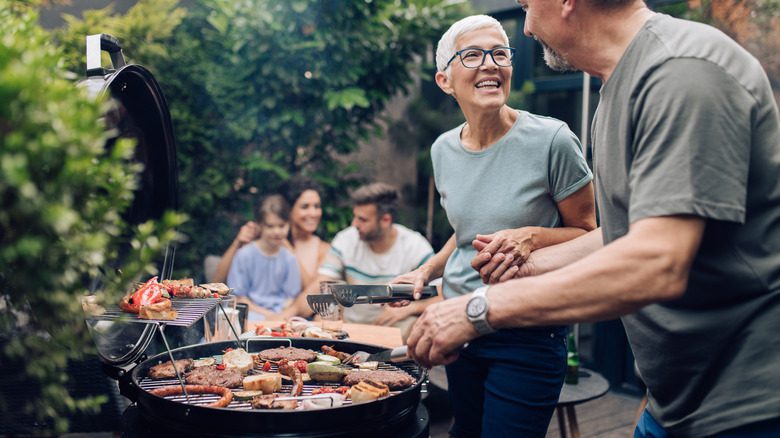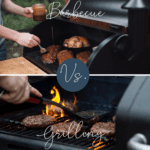
Cooking enthusiasts often use the terms “grilling” and “barbecuing” interchangeably, but there are distinct differences between the two methods. While both take place on a grill, grilling involves high, direct heat and is a faster process. On the other hand, barbecuing requires low temperatures and a longer cooking time to infuse the food with a smoky flavor. Grilling is versatile, allowing for a wide range of ingredients to be cooked, while barbecuing is typically used for larger cuts of meat. Understanding these differences will help you determine if your next outdoor cooking adventure is a real barbecue or simply grilling.
The Difference Between Barbecuing and Grilling Explained

This image is property of www.chowhound.com.
Introduction
In the world of cooking, there are many terms that describe different ways of preparing food. Two terms that are often used interchangeably but actually require very different techniques are “grilling” and “barbecuing.” While there are similarities between the two methods, understanding the difference can help you become a master of both. In this article, we will explain the distinctions between grilling and barbecuing, including the cooking temperatures, cooking times, and the types of food commonly prepared using each method.
Grilling utilizes high, direct heat
When you grill, you cook your food over an open flame, using high temperatures usually around 400 degrees Fahrenheit. Grilling is a faster cooking process compared to barbecuing because of the intense heat. The food comes into close contact with the fire, allowing it to develop a flavorful crust and sear. To ensure proper cooking, the hood of the grill is usually kept open during grilling to prevent the food from burning. With grilling, all you need to do is flip the food halfway through the cooking time, ensuring that nothing catches on fire. It’s a simple and straightforward cooking method.
Grilling is an incredibly versatile cooking technique
One of the greatest benefits of grilling is its versatility. You can grill a wide range of foods, from fruits and vegetables to seafood kebabs and steaks. Some of the most popular foods served at a barbecue, such as hamburgers and hotdogs, are often grilled. The grill lines that appear on grilled foods not only add visual appeal, but they also enhance the flavor. Grilling is a simple cooking method that can be mastered with practice. Whether you’re a beginner or an experienced cook, grilling offers a wide range of possibilities for creating delicious meals.
Barbecuing takes more time
Barbecuing, on the other hand, requires more time and attention. The key to barbecuing is cooking at low temperatures, usually around 250 degrees Fahrenheit, and maintaining that temperature for several hours. Depending on the type of food you’re cooking, barbecuing can take even an entire day. Due to the longer cooking time, the cook needs to give sustained attention to the barbecue to ensure the grill stays at the proper temperature. While maintaining the temperature is relatively simpler with a gas grill, which only requires adjusting the burners and keeping the hood closed, charcoal grills require regular temperature checks and charcoal refills to maintain a consistent heat source.
Barbecuing requires low temperatures
One of the defining characteristics of barbecuing is the use of low temperatures. The low heat allows for slow cooking and tenderizing of meat. Barbecuing at lower temperatures also prevents the food from burning. By cooking the meat slowly, the connective tissues break down, resulting in a tender and juicy final product. The low-and-slow method used in barbecuing infuses the meat with a distinct smoky flavor that is beloved by barbecue enthusiasts.
Barbecuing requires sustained attention
As mentioned earlier, barbecuing requires sustained attention from the cook. The challenge lies in ensuring that the grill maintains a consistent temperature throughout the cooking process. With gas grills, this involves adjusting the burners and keeping the hood closed. For charcoal grills, regular temperature checks and charcoal refills are necessary to maintain the desired heat level. This sustained attention is essential to achieve the desired texture and flavor in barbecued meats.
Grilling focuses on small, individual servings
Grilling is well-suited for cooking small, individual servings of food. Whether it’s a few burgers, a row of asparagus, or even seafood skewers, grilling allows you to cook these servings quickly and evenly. The cooking time may vary depending on the type of food being grilled, but flipping the food halfway through the cooking process is generally necessary to ensure even cooking on each side. Grilling individual servings is a convenient option for smaller meals or when you want to cater to individual preferences.
Barbecuing is used to cook larger items
Barbecuing, on the other hand, is best for cooking larger items. Rather than individual servings, barbecuing involves cooking whole cuts of meat, such as an entire rack of ribs or a whole pork leg. These larger cuts require a longer cooking time to achieve the desired tenderness and flavor. The closed hood of the barbecue grill allows the smoke to infuse the meat, creating the iconic smoky barbecue flavor that is loved by many. The process of barbecuing is not just about cooking the food; it’s about creating an experience and a centerpiece for a barbecue party.
Barbecuing creates a smoky, barbecue flavor
One of the key differences between grilling and barbecuing is the smoky flavor that barbecuing imparts on the food. The low and slow cooking method used in barbecuing allows the meat to bathe in the smoke produced by the grill. This smoke enhances the flavor of the meat, giving it a distinct and delicious taste. The closed hood of the barbecuing grill traps the smoke, allowing it to penetrate the meat and create that signature barbecue flavor that we all know and love.
Conclusion
In conclusion, understanding the difference between grilling and barbecuing is essential for anyone who enjoys cooking outdoors. While both methods use a grill, they require different techniques and offer unique flavors and experiences. Grilling utilizes high, direct heat and is suitable for a wide range of foods, while barbecuing requires low temperatures, sustained attention, and is used for larger cuts of meat. Whether you’re grilling or barbecuing, both methods can create delicious meals that are sure to be enjoyed by friends and family at any gathering. So fire up the grill or barbecue and enjoy the flavors of outdoor cooking!






